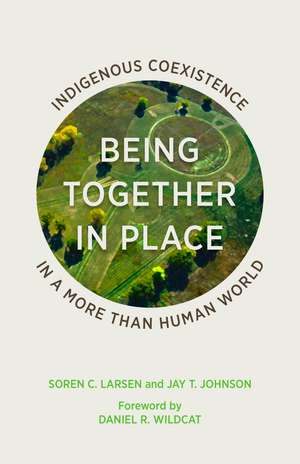Being Together in Place: Indigenous Coexistence in a More Than Human World
Autor Soren C. Larsen, Jay T. Johnsonen Limba Engleză Paperback – noi 2017
Being Together in Place explores the landscapes that convene Native and non-Native people into sustained and difficult negotiations over their radically different interests and concerns. Grounded in three sites—the Cheslatta-Carrier traditional territory in British Columbia; the Wakarusa Wetlands in northeastern Kansas; and the Waitangi Treaty Grounds in Aotearoa/New Zealand—this book highlights the challenging, tentative, and provisional work of coexistence around such contested spaces as wetlands, treaty grounds, fishing spots, recreation areas, cemeteries, heritage trails, and traditional village sites. At these sites, activists learn how to articulate and defend their intrinsic and life-supportive ways of being, particularly to those who are intent on damaging or destroying these places.
Using ethnographic research and a geographic perspective, Soren C. Larsen and Jay T. Johnson show how the communities in these regions challenge the power relations that structure the ongoing (post)colonial encounter in liberal democratic settler-states. Emerging from their conversations with activists was a distinctive sense that the places for which they cared had agency, a “call” that pulled them into dialogue, relationships, and action with human and nonhuman others. This being-together-in-place, they find, speaks in a powerful way to the vitalities of coexistence: where humans and nonhumans are working to decolonize their relationships; where reciprocal guardianship is being stitched back together in new and unanticipated ways; and where a new kind of “place thinking” is emerging on the borders of colonial power.
Using ethnographic research and a geographic perspective, Soren C. Larsen and Jay T. Johnson show how the communities in these regions challenge the power relations that structure the ongoing (post)colonial encounter in liberal democratic settler-states. Emerging from their conversations with activists was a distinctive sense that the places for which they cared had agency, a “call” that pulled them into dialogue, relationships, and action with human and nonhuman others. This being-together-in-place, they find, speaks in a powerful way to the vitalities of coexistence: where humans and nonhumans are working to decolonize their relationships; where reciprocal guardianship is being stitched back together in new and unanticipated ways; and where a new kind of “place thinking” is emerging on the borders of colonial power.
Preț: 140.42 lei
Preț vechi: 162.74 lei
-14% Nou
Puncte Express: 211
Preț estimativ în valută:
26.88€ • 27.65$ • 22.30£
26.88€ • 27.65$ • 22.30£
Carte indisponibilă temporar
Doresc să fiu notificat când acest titlu va fi disponibil:
Se trimite...
Preluare comenzi: 021 569.72.76
Specificații
ISBN-13: 9781517902223
ISBN-10: 1517902223
Pagini: 264
Ilustrații: 15 black and white illustrations, 8 maps
Dimensiuni: 140 x 216 x 18 mm
Greutate: 0.34 kg
Ediția:1
Editura: University of Minnesota Press
Colecția Univ Of Minnesota Press
ISBN-10: 1517902223
Pagini: 264
Ilustrații: 15 black and white illustrations, 8 maps
Dimensiuni: 140 x 216 x 18 mm
Greutate: 0.34 kg
Ediția:1
Editura: University of Minnesota Press
Colecția Univ Of Minnesota Press
Notă biografică
Soren C. Larsen is associate professor in the Department of Geography at the University of Missouri.
Jay T. Johnson is associate professor in the Department of Geography and Atmospheric Science at the University of Kansas.
Daniel R. Wildcat is a Yuchi member of the Muscogee Nation of Oklahoma. He is director of the Haskell Environmental Research Studies Center.
Jay T. Johnson is associate professor in the Department of Geography and Atmospheric Science at the University of Kansas.
Daniel R. Wildcat is a Yuchi member of the Muscogee Nation of Oklahoma. He is director of the Haskell Environmental Research Studies Center.
Cuprins
Contents
Foreword
Daniel R. Wildcat
Acknowledgments
Introduction: Being-together-in-place
Part I. “The Spirit of My Ancestors:” Cheslatta Carrier Nation Traditional Territory
1. Pathways of Coexistence
2. Sacred Ground
Part II. “You Can’t Stop the Ceremonies:” The Wakarusa Wetlands
3. Ceremony Is Protest, Protest Is Ceremony
4. Reciprocal Gaurdianship
Part III. “Hīkoi Ngātahi/Going Forward Together:" Waitangi Treaty Grounds, Aotearoa/New Zealand
5. Treaty Partnership
6. Manaakitanga
Conclusion: Coexistence in a More-than-human World
Appendix: The Treaty of Waitangi/Te Tiriti o Waitangi
Glossary of Māori Language Terms
Notes
Bibliography
Index
Foreword
Daniel R. Wildcat
Acknowledgments
Introduction: Being-together-in-place
Part I. “The Spirit of My Ancestors:” Cheslatta Carrier Nation Traditional Territory
1. Pathways of Coexistence
2. Sacred Ground
Part II. “You Can’t Stop the Ceremonies:” The Wakarusa Wetlands
3. Ceremony Is Protest, Protest Is Ceremony
4. Reciprocal Gaurdianship
Part III. “Hīkoi Ngātahi/Going Forward Together:" Waitangi Treaty Grounds, Aotearoa/New Zealand
5. Treaty Partnership
6. Manaakitanga
Conclusion: Coexistence in a More-than-human World
Appendix: The Treaty of Waitangi/Te Tiriti o Waitangi
Glossary of Māori Language Terms
Notes
Bibliography
Index
Recenzii
"Being Together in Place offers a radical vision of decolonization grounded in Indigenous peoples' ontologies of land and place. It's a crucial intervention that weds the best insights from critical Indigenous studies to geography in exciting and transformative ways."—Glen Sean Coulthard, author of Red Skin, White Masks
